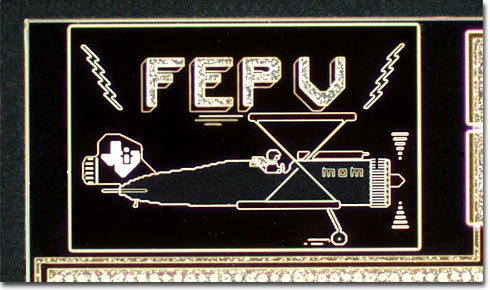Texas Instruments Biplane (Darkfield)
|
Texas Instruments chip designers have a definite affinity for all modes of transportation. We have discovered a wide variety of interesting vehicles on their chips including the Space Shuttle, an Apollo-era Lunar Excursion Module, a miniature rendition of the USS Enterprise, and a sailboat. It was no surprise to us when we stumbled across this silicon biplane on a TI 64K DRAM chip made at the Miho plant in Japan during the early 1980s. Accompanying the biplane are the initials (presumably an acronym) "FEPV" and a pair of lightning bolts. A search of the TI website did not reveal the meaning of the acronym. Also, on the cowling of the biplane, behind the engine, are the initials "MOM", the meaning of which is also a guess. The Texas Instruments logo with the letters "TI" inside a map of Texas adorns the tail of the biplane. Chip designer Doug Mendez, who was the product engineer (responsible for yield, process, and test issues) for this chip, has provided us with information concerning the chip and its silicon doodle. According to Doug, FEPV stands for Front End Process 5 (using the Roman numeral V), part of the fabrication sequence used to make the integrated circuit. This RAM chip was made in LMOS2 (Lubbock Metal Oxide Semiconductor) FAB #2 in Lubbock, Texas on 4-inch wafers in 1981, and was code named the 4164. This photomicrograph was derived from a chip housed in the Smithsonian Institution integrated circuit collection (catalog number: 87.487.11 [G00300]). View this silicon artwork under differential interference contrast and brightfield illumination. |
© 1995-2025 by Michael W. Davidson and The Florida State University. All Rights Reserved. No images, graphics, software, scripts, or applets may be reproduced or used in any manner without permission from the copyright holders. Use of this website means you agree to all of the Legal Terms and Conditions set forth by the owners.
This website is maintained by our
|
